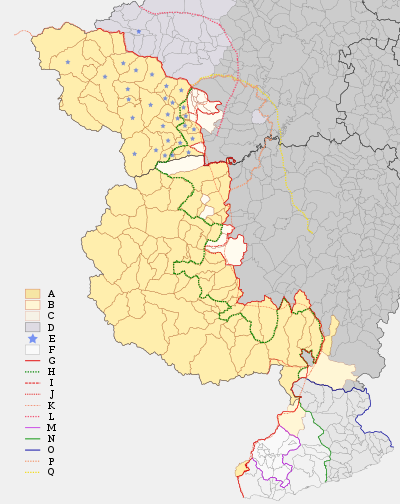
The Occitan Valleys (Occitan: Valadas Occitanas; Italian: Valli Occitane; Piedmontese: Valade Ossitan-e; French: Vallées Occitanes; Arpitan: Valâdes Occitanes) are the part of Occitania (the territory of the Occitan language) within the borders of Italy. It is a mountainous region in the southern Alps. Most of its valleys are oriented eastward and descend toward the plains of Piedmont.
The area has a population of 174,476 inhabitants (July, 2013). Its major towns are Lo Borg Sant Dalmatz (Borgo San Dalmazzo), Buscha (Busca), Boves (Bueves) and Draonier (Dronero).
The Occitan linguistic enclave of La Gàrdia (Guardia Piemontese) in Calabria does not belong to the Occitan Valleys.
A 1999 Italian law ("Law 482") provides for the protection of linguistic minorities, including Occitan.[11]
These are the villages where an autochthonous Provençal-speaking community has surely settled and may still speak the language. Around 35% of the population (stats by Enrico Allasino, IRES 2005 and IRES Piemonte no.113/2007) declared to be able to speak or understand the local Provençal language, with various levels of proficiency. Italian and Piedmontese are spoken by the majority of the people in the area, and the patois is much influenced by both the other two languages.
In these communities, apart from Italian, the most widely spoken language is Piedmontese. In the past, in the lower Val Chisone, Waldensian communities were the major part of the population. Chisone, Pellice and Germanasca Valleys were referred as "Waldensian Valleys" and the local Provençal speech was called "Waldesian language", and it was opposed to the language of the Catholic population which was Piedmontese. The Lower Chisone Valley in the 20th century had a rapid industrial growth, and since then the Waldensian was replaced by Piedmontese in the most bustled villages. In Oncino and Crissolo the local patois disappeared after a dramatic depopulation.
These are the communities which are referred as "Occitan" in the text of the 482/99 Act, and by the agency of linguistic safeguard Chambra d'Oc, even if there was no previous source which supported this appellation. All these villages and towns lack the historical rootedness of the linguistic minority, because no linguist noticed any Occitan presence before the law. In these cases the Provençal translation of the place name doesn't exist, or it's an exonym used by the patoisants of the upper valleys to indicate the lower valley settlements, or it is the transliteration in Occitan orthography of the Piedmontese/Ligurian toponym.